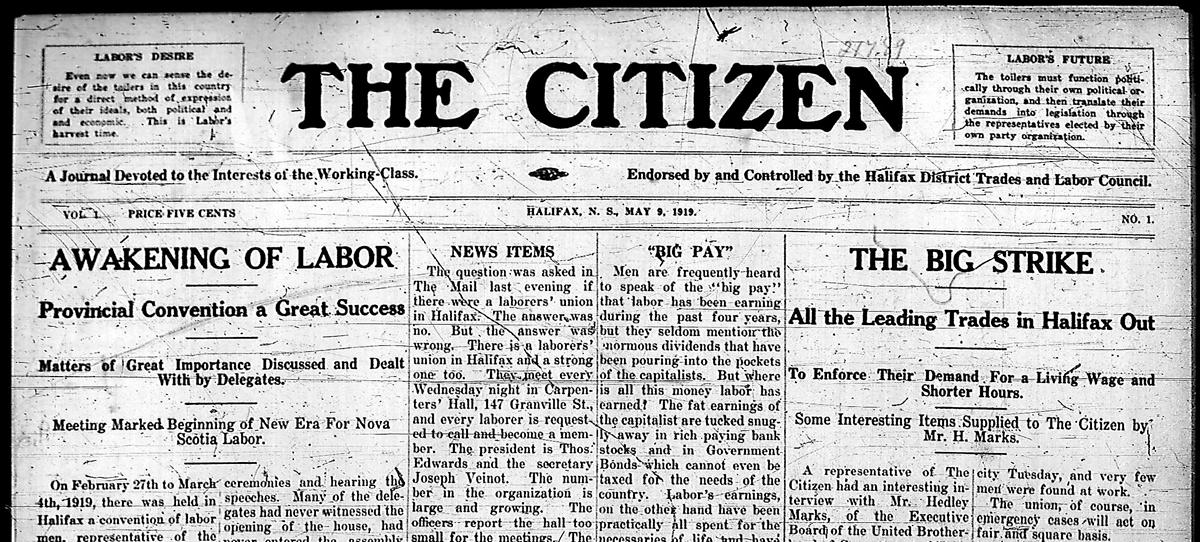|
May 9, 2019
Lockout at
Glencore's Smelter
in Belledune, New Brunswick
Struggle Continues
Against Glencore's Anti-Worker Concessionary Demands

• It's Our
Turn -- No Concessions!
• Resistance to Arrogant Actions of Glencore
In Defence of Workers'
Rights
• Sit-Ins and Occupations by New Brunswick
Nursing Home Workers
100th Anniversary of
the Halifax General Strike
• A Militant Tradition of Workers' Struggles in
the Atlantic Provinces - Tony
Seed
Lockout at Glencore's Smelter
in Belledune, New Brunswick

May 8 marked the end of the second week of the Glencore
Brunswick Smelter workers' job action in Belledune. The 281 production
and maintenance workers, members of USW Local 7085, are united in
action to defend their rights against the mining and metallurgy
Glencore's demand for anti-worker concessions.
As is now becoming routine for global oligopolies such
as Glencore to show their arrogance and refusal to negotiate, it locked
out the workers before their announced strike was to begin in the
evening, under the hoax of protecting the safety of the plant. With the
sudden and unannounced lockout, Glencore revealed that it had been long
preparing to attack the workers. On April 24, the day it locked out the
workers, the global monopoly sought a court order from the Court of
Queen's Bench of New Brunswick, which it obtained on April 26, limiting
the number of picketers to six at the entrances or exits of the smelter
and at any other geographical location in New Brunswick where it
conducts business. The court also ordered the workers not to obstruct
in any way any movement of employees, customers, suppliers and others
to and from the plant or to "harass" them, including a prohibition of
taking photographs. Glencore soon followed up this court order
obtaining a second one making it "illegal" for picketers to conceal
their identity, including by covering their faces.
The global monopoly further revealed its intention to
refuse to negotiate and provoke a strike or lockout by having already
organized "strike security teams" that are reported to be housed in
fancy hotels and provided with vehicles for the duration of the
strike/lockout. The monopoly had also hired scab labour from Quebec to
drive the trucks
bringing mined concentrate into the smelter.
These conscious preparations are not the activity of a
company with intentions of negotiating a contract that workers can find
acceptable. The global oligopoly with the backing of the state and
using its vast social wealth and power is showing its fangs and
anti-worker hatred with this attempt to impose its dictate and drive
down the working
and living conditions of workers.


The locked-out New Brunswick smelter workers are not
intimidated by the actions of Glencore. They have put the slogan "It's
Our Turn -- No Concessions" on their website and are calling on the
working people to unite behind their just cause. They
say that they have already made huge concessions over the last three
contracts, especially in the 2014 contract, just after the Glencore
empire seized
control of the former owners, Xstrata. The increased global power and
the concessions reluctantly accepted by workers in recent contracts,
workers say have emboldened the oligarchs not only to demand more and
more but to crush the union, silence their voice and establish a labour
relations climate marked by open hostility towards the workers
and contempt for their health and safety.
" Years of sacrifices by
workers and their families have not been reciprocated with good-faith
behaviour by Glencore, at the bargaining table or in the workplace,"
said USW Local 7085 President Bart Dempsey. "For years our members have
accepted concessions and worked with Glencore to help make our smelter
a success. In return, Glencore
has responded with a management culture that has become increasingly
hostile towards its workers and, of course, demands for more
concessions," he added. Years of sacrifices by
workers and their families have not been reciprocated with good-faith
behaviour by Glencore, at the bargaining table or in the workplace,"
said USW Local 7085 President Bart Dempsey. "For years our members have
accepted concessions and worked with Glencore to help make our smelter
a success. In return, Glencore
has responded with a management culture that has become increasingly
hostile towards its workers and, of course, demands for more
concessions," he added.
Dempsey told Workers' Forum that experience has
shown that in no way can workers entrust their health and safety to
Glencore management. This has been proven once again in practice by the
company's demand that the fulltime position of the union's health and
safety representative be reduced to a parttime position and deprived
of
his current office in the plant to meet fellow workers.
Workers reject the company slander that workers with
their resistance against further concessions are "disconnected from the
global market in which the smelter is trying to survive." Workers have
direct experience that concessions imposed by the company have worsened
all aspects of life at the plant and in retirement and that those
concessions have whetted the appetite of the beast for more. Besides,
workers point out, they have no control over the global market, its
mindless anti-people competition and the adventures of the oligopolies
to realize their aim of narrow private profit. The anti-people aim and
actions of the global oligopolies such as Alcoa, GM and Glencore have
nothing to do with bringing prosperity to any nation. They merely
enrich those whose unscrupulous swindles win out in the short-term and
then they need another swindle to remain "in business." Workers can in
no way base their aspirations, actions and demands for security and
what belongs to them by right on the anarchy and violence which
accompanies the global competition of the oligopolies. Glencore's
refusal to negotiate is a form of violence as well. With the connivance
of the courts and other state institutions, as well as governments,
such narrow private interests extort what they want without any regard
for the lives of the people whose safety they threaten. The workers'
cause is just and deserves the support of all Canadians.


A contingent of USW workers from Glencore travelled to Glencore's AGM
in Switzerland, May 9, 2019 to protest attacks on their rights.
Glencore smelter workers gave ample notice that their
strike in defence of their rights was to begin the evening of April 24.
Upon arriving for work in the morning of the strike, the global
monopoly Glencore, without any notice, locked them out. The company
began
blocking workers from entering the plant without any official notice.
This
showed their intent to refuse to negotiate.
Refusing to negotiate and locking out workers when they
refuse to accept the dictate of global monopoly is becoming a frequent
tactic in attacking the rights of the working class. Global private
empires, such as Glencore, use lockouts and state-organized attacks
such
as court injunctions to criminalize and intimidate workers and attempt
to make
them give up the just defence of their rights and well-being at work
and in retirement, and their claim on what they produce which belongs
to
them by right.
 The Belledune smelter
workers, similar to others such as the ABI workers in Quebec, who have
organized a grand solidarity march in Trois-Rivières for May 25,
are facing these private global empires that have state-organized
backing. Workers are finding they are not alone, isolated and without
options in their struggle. They are organizing
joint actions and reaching out to Canadians to find strength in numbers
and to form the public opinion and solidarity they need to confront
these global robber barons and their political representatives in
government. The Belledune smelter
workers, similar to others such as the ABI workers in Quebec, who have
organized a grand solidarity march in Trois-Rivières for May 25,
are facing these private global empires that have state-organized
backing. Workers are finding they are not alone, isolated and without
options in their struggle. They are organizing
joint actions and reaching out to Canadians to find strength in numbers
and to form the public opinion and solidarity they need to confront
these global robber barons and their political representatives in
government.
On May 9, a delegation of Glencore workers is in Zug,
Switzerland on the occasion of the company's annual general meeting.
The delegation is working with representatives of the IndustriALL
Global Union, of which the United Steelworkers is an affiliate.
Together the unions are expressing their opposition to the anti-worker
dictate of the global oligopoly building unity with fellow workers.
They will also participate in the annual general meeting to protest the
company's attacks on their health, safety and rights and press
Glencore's global executives to take a stand in favour of a negotiated
collective agreement acceptable to the workers.

Sit-Ins and Occupations by New Brunswick
Nursing Home Workers

On May 4, 2019 executive members of the NB Council of Nursing Home
Unions end their occupation of the Fredericton office of New
Brunswick's Minister of Social Development and continued to press for
their demands through sit-ins at Cabinet members' constituency offices.
Nursing home workers in New Brunswick are stepping up
their actions to obtain wages needed both to stop their growing
impoverishment and to retain and attract workers to the sector. They
have rejected the so-called mandate that the provincial government has
decreed, according to which public bodies must hold wage increases to
one
per
cent or less per year.
The Conservative government declaration of a mandate to
attack the working class follows the same policy as that of the
previous Liberal government. Nursing home workers have firmly rejected
this and are determined to unite in action to break the mandate. The
provincial government in its retrogressive and provocative propaganda
is
spreading the neo-liberal falsehood that nursing home workers and all
public sector workers are a cost to the province that has to be reduced
and not an essential asset in humanizing society and contributing
precious value to the economy.

Executive members occupy Minister of Social
Development's office, May
1, 2019.
|
Day and night from May 1 to May 4, executive members of
the NB Council of Nursing Home Unions occupied the Fredericton office
of New Brunswick's Minister of Social Development. During the
occupation, members of the Council and supporters organized
demonstrations outside and sent in food and drinks. Security prevented
media
from entering the building to talk to the Council members so press
scrums were held through the windows.
One demand of the workers occupying the office was to
talk, even by phone, with either the Premier or the Minister to
reaffirm the stand of the workers in defence of their right to
improvements in their wages and working conditions, a stand from which
they will not retreat. The workers were also asking for a copy of the
new offer that the
government says it has prepared, which allegedly improves on the
previous offer that the workers firmly rejected. This conversation
never took place.
The Minister publicly denounced the occupation as a
"bullying" tactic without commenting on, apologizing for, or better
still eliminating, his government's mandate and use of police powers to
bully all public sector workers.
Another aim of the occupation was to denounce the
never-ending state-organized judicial saga being used against the
workers to deny them their right to strike. Workers are being blocked
from exercising their right to withdraw their labour in support of
their just demands. Denying workers' right to engage in job actions
also delays finding real
solutions to the problems that workers and residents of nursing homes
are facing.
The latest event in the judicial saga is an April 25
decision by the New Brunswick Court of Appeal. The decision sided with
the province by overturning a lower court ruling rejecting the original
court order denying workers their right to strike. The judge in that
decision ruled the punitive order was doing irreparable harm to the
workers. The
government immediately appealed and had its anti-worker dictate upheld.
Another legal process is also underway reviewing the
constitutionality of the Essential Services in Nursing Homes Act,
which
is
to
be
heard
on
May
24.[1]
In the meantime nursing home workers are denied their right to strike
until that review is completed and serious problems are left
unresolved.
Workers are fed up with these endless court cases. They
have made clear for a long time that what they want is negotiations in
which their demands and concerns are heard and respect is shown for the
work they do. Their aim is to achieve working conditions and wages
acceptable to themselves and to find real solutions to real problems in
the
sector. A strike is not their aim. At the same time, they need to be
able to withdraw their capacity to work if that is what is required to
push for their demands. They have even proposed to the government that
binding arbitration be used to settle the dispute. The government
responded to this proposal with the provocation that it would agree to
submitting the dispute to binding arbitration on condition that the
arbitrator abide by the one per cent dictate on wage increases, thus
defeating the entire purpose of arbitration.
The executive members of the Council decided on May 4,
to end their occupation of the Minister's Office and switch to regional
actions of one-day sit-ins in constituency offices of Cabinet
Ministers. Nursing home workers organized actions at eight Ministers'
offices in cities across New Brunswick on Monday May 6, the day of the
week
Ministers are supposed to be in their constituency to meet their
constituents. Some Ministers left their offices before the sit-ins to
avoid any contact with the workers while others closed their offices
for the day. Regardless, workers used the occasion to denounce the
government's attacks on public sector workers and nursing home workers
in
particular.
The 4,100 nursing home workers have been trying to
negotiate a contract since 2016. Negotiations are scheduled for May 11
and the workers are demanding progress to achieve wages and working
conditions acceptable to themselves and to humanize the sector for the
sake of those in their care.

Workers participate in actions at eight cabinet minister's constituency
offices, May 6, 2019.
Note
1. At the end of 2018, the New
Brunswick Labour and Employment Board ruled that the Essential Services
in Nursing Homes Act violated the right to collective bargaining
for
employees. According to the ruling, the designation of essential care
services in the event of a strike does not apply to
nursing homes. The government intervened to seek a judicial review of
this decision, which has yet to be heard.

100th Anniversary of the Halifax General
Strike
- Tony Seed -

May First, international working class day, marked the
100th anniversary of the Halifax General Strike of 1919. Events in
Halifax in 1919 and after must be seen within the context of both
regional, national and international developments and working-class
activity. Between 1916 and 1925 the Maritimes experienced unparalleled
levels of strike activity. Significantly this upsurge was not confined
to the coal mining communities of the region. Economic militancy often
translated into political action. Miners in Cape Breton, Cumberland,
and Pictou counties, steelworkers in Sydney, and industrial workers in
Amherst and New Glasgow participated in the upsurge of radicalism seen
across the country. In March 1919 a "great mass meeting" in Sydney
endorsed a resolution by Nova Scotia Federation of Labour organizer
C.C. Dane for a strike of all Nova Scotia workers if the provincial
government failed to enact legislation for an eight-hour day.[1]
The Halifax General Strike
The Halifax General Strike targeted war profiteering and
super-exploitation of the construction trades in the wake of the
Halifax Explosion of December 6, 1917.
When the explosion took place, official figures
suspected by
many to be understated, say 1,963 residents of the city
were killed, another 9,000 injured and 199 blinded -- comprising
more than one-fifth of a total population of less than 50,000 --
of whom 5,000 were soldiers and sailors, not including those
convalescing in military hospitals from wounds suffered in
Europe. Between 20,000 and 25,000 Haligonians were left homeless
and destitute, including 10,000 children.
The recounting of the Explosion tends to deny the causal
link between the disaster and the stepped up exploitation of the
working class and its impoverishment and resistance at that time. For
example, under the pretext of dealing with the consequences of the
Explosion, the rich recruited unskilled migrant labour, including from
China, to replace the fallen longshoremen to keep Halifax functioning
as a war port and to drive down wages, split the workers' solidarity,
and break down the closed union shop. In February 1918, an Ontario
labour paper, the Industrial Banner,
referred
to
a
group
of
Chinese
labourers
who
had
frozen to death en
route to Halifax and criticized the injustice of employing foreign
labour when "[h]ardly a day passes but news comes of men and women
being notified that their services are no longer required."
Picking themselves up from the disaster, the Halifax
workers rose against the injustices, urban land grabs and profiteering
from the misery prevailing after the Explosion by the unscrupulous men
of property. This culminated in a general strike of over 1,100 building
trades workers launched on May Day, 1919.
Called at the time "The Big Strike," it was the largest
strike in the history of Halifax. Along with being the international
day of working class unity and solidarity, May First was the
traditional date for establishing new wage rates in Halifax.
Impulse to the Development of the Workers' Press
On May 9, 1919, under the auspices of the Halifax Trades
and Labour Council, Halifax workers began publishing a weekly
newspaper, significantly named The
Citizen, capable of "presenting
labour's case to the public." On its front page, it noted:
"It is a regrettable and serious thing, but it seems
only too
true that the large daily newspapers of Canada and, in fact, the
press generally, have entirely ceased to stand for the people's
interests. They appear to have become tied up with the big
interests. They have become advocates of measures and doctrines
which, in other countries, have produced military and political
domination and subversion of the people's rights.
"Organized labour, during the long struggle for the
recognition of its rights, has always stood firm for liberty of
speech and action for all classes. This is something which the
capitalistic class cannot claim. In fact, the only hope for
restoring freedom of speech and action in this country lies in
the labour movement. All who believe in free speech, therefor,
should support labour."
The Citizen advocated "the principles of
independent
political action." The Halifax Labour Party was revived by the
Halifax Trades & Labour Council, inviting all "workers, whether
organized or unorganized, mental or manual regardless of race,
sex, creed or vocation." On July 27, 1920, the Independent Labour
Party, in alliance with the United Farmers of Nova Scotia, won
the greatest electoral support for any left-wing party in the
history of the Maritimes with 11 seats, five being labour. Cape
Breton itself sent four labour MLAs to Halifax, also with the
highest majority.

The Amherst Strike
On May 20, 1919, the locally organized industrial union,
the independent Amherst Federation of Labour, called "a general strike"
of organized labour in that town, partly in sympathy with the workers
of the Canadian Car and Foundry Company who had failed to achieve
parity with the Montreal branch, and partly to back the demands for an
eight-hour day, union recognition, and improved working conditions in
individual plants. With two exceptions, the three-week strike included
4,000 workers in all the town's major industries: foundries,
engineering works, textile mills, shoes, luggage, and wood-working
factories, and even the local garage. The Amherst Federation of Labour
wrote that Nolan Eilly "directed all negotiations with the various
companies and organized daily rallies for information and agitational
purposes. At these meetings local labour leaders promoted the One Big
Union (OBU) as the only organization with the strength and
determination to confront capitalism on local and national issues."[2]
Also in May 1919, more than 15,000 paper-mill workers in
Canada and the U.S., who produced 60 per cent of all newsprint, struck
against a 30 per cent wage cut.
The Halifax Shipyard Strike
High levels of struggle were developed by shipyard
workers in
Halifax and coal miners and steel workers in Cape Breton against
private absentee British owners.
A still larger strike of shipyard workers broke out in
June
1920. The shipyards were now owned by the newly-formed British
Empire Steel Corporation (BESCO), the largest industrial
consortium in Canada. At the time, the Sydney steel plant was the
largest in Canada. Cape Breton produced 45 per cent of all
Canadian coal production.[3]
Centring upon Halifax Shipyards Limited, the strike
affected
eight
companies, an average of 2,000 workers, and lasted 52 working
days. With the total loss of 104,000 man-days it accounted for
over 12 per cent of the total strike days in Canada during
1920.
It would remain the largest single manufacturing
strike to involve one community's industrial workers until after
World War II.
The International Typographical Union strike, which
lasted from
May 1921 until August 1924 to establish the eight-hour day, was
actually the biggest skilled-labour strike.
 
The Citizen,
June 4, 1920; June 18, 1920 (click to enlarge).
The Cape Breton Resistance
In the 1920s, exercises of state power against the
working
class became a regular feature of Cape Breton strikes. The
collectives of steel workers, coal miners (many of whom were
Gaelic speakers), and the Black community of Whitney Pier of
African-Caribbean origin were all in motion.
In August 1922, a strike of the coal miners was declared
in
which the resolution was put forth that:
"We proclaim openly to all the world that we are out for
a
complete overthrow of the capitalist system and of the
capitalist, peaceably if we may; forceable if we must; and we
call on all workers, soldiers and minor law officers in Canada to
join us in liberating labour."[4]
The 12,000 coal miners resisted a one-third wage
reduction
imposed by BESCO with a major strike involving new tactics:
restriction of output by one-third, and the enforcement of a 100
per cent strike; all workers left the mines. Ottawa turned Cape
Breton into an armed camp, deploying one-third of the Canadian
army. Ottawa deployed 4,000 members of the Royal Canadian
Regiment with 18-pound field guns to maintain "order" around
BESCO facilities. The British Navy deployed a battleship from
Newfoundland waters to suppress their militant struggle to
organize into the union of their choice. Nova Scotia officials
requested an additional 2,000 troops, British battleships then in
Newfoundland waters, and an airplane squadron. One commanding
officer even called for air strikes. Cape Breton County was
declared a police district, with a 1,000-men police force
authorized.[5]

Royal Canadian Dragoons occupy Cape Breton in
1922.
In 1923 "The Red Flag," written by Irishman James
Connelly,
was sung at the first Cape Breton May Day Parade in Glace Bay.
James B. McLachlan, the mass leader of the Cape Breton coal
miners was also a member of the newly-formed Communist Party and
one of the most significant Canadian labour leaders. He described
the May Day Parade:
"May Day was held in Glace Bay this year for the first
time.
Four thousand workers, clear eyed and triumphant, marched with
flag and banner in that parade. All day there was a steady
downpour of icy rain but it was neither wet enough nor cold
enough to dampen the fine spirit of these working men and women
marchers. [...] With song and speech, with comradely greetings
these four thousand men and women spent one gloriously free eight
hours away from the eye of the boss and his heart-breaking job
which barely provides them and their children with bread. A
glorious day which made one's blood run warmer and faster with
the hopeful thrill of the new life when all of the days of the
year shall belong to labour and when the accursed words 'master
and boss' shall be banished from the earth along with the thing
which these represent. On May Day we forgot the barriers of
nationalism erected by the masters of bread and sent words of
fraternal greetings to the struggling workers of every land. The
workers of this land are our comrades and brothers, the
capitalists of this land our robber enemies. The complete
solidarity of the former is our hope, the complete extermination
of the latter our aim. Long live May Day! Long live the
solidarity of the World's workers!"[6]
In June 1923 the coal miners struck in solidarity with
the
steelworkers of Sydney, who were fighting for the recognition of
their union.
On June 30, the first of many troop trains was sent to
Sydney,
including an armoured gondola piled high with sand bags and
bristling with machine guns. Provincial police (or "Armstrong's
Army") were again sent to Cape Breton and ran riot on Victoria
Road on July 1 assaulting residents as they returned home from
church. They were soon joined by federal troops. This came to be
known as Cape Breton's infamous "Peterloo" or "Bloody
Sunday."
J.B. McLachlan circulated a notice urging other mining
unions
to walk out in support. Branding the Nova Scotia government "the
guilty and responsible party" for the attack, he called on his
fellow unionists "to spread the fight against (Premier) Armstrong
to every mine in Nova Scotia." Eventually, the miners closed not
only Cape Breton and mainland mines, but District 18 in Alberta
came out as well in support of the steelworkers to protest the
renewed use of armed force in the industrial area. Many miners
had served in the war that ended only five years before the
strike. Many were prepared to fight an enemy that they considered
as threatening to their survival as any they had faced across
No-Man's Land in Europe.
Glace Bay refused to pay the cost of the military
forces, as
provided by the Militia Act. "The larger mining towns were
no longer company towns; they elected labour candidates, who
engaged in protracted disputes with the coal company over taxes
and assessments and services, and supported the union in times of
crisis."[7]
"Red" Dan Livingstone, miners' president, and J.B.
McLachlan,
the secretary-treasurer,[8]
were
arrested and jailed. "Fighting
Jim," as he was known in the press, was convicted in December
1923 on trumped-up charges of three counts of sedition --
unlawfully inciting public disorder or promoting hatred of the
government -- and jailed for two years at the Dorchester
Penitentiary for articles written in the Maritime Labour
Herald, of which he was editor. It was little more than a
show trial: Attorney General Walter J. O'Hearn, who prosecuted,
insisted on a Halifax trial for fear sympathetic Cape Breton
jurors would acquit someone with the courage to champion their
cause. In his instructions to the jury, Justice Humphrey Mellish
of the Supreme Court, a former coal company lawyer, could barely
disguise his distaste for McLachlan and the Marxist ideals he
espoused. Legal historian Barry Cahill has labeled it a "gross
miscarriage of justice."
McLachlan's lawyers managed to have one count dismissed
on
appeal -- the charge of publishing seditious material in Halifax,
since it had emerged at trial that a BESCO official had leaked
the notice to the Halifax newspapers. He was sentenced to two
years in prison but paroled after serving less than five months.
His death in 1937, when he was in his late 60s, was blamed on a
lung ailment picked up while confined to the damp cells of
Dorchester Penitentiary.
Notes
1. Ernest R. Forbes, The Maritime
Rights Movement,
1919-1927,
p. 41.
2. Reilly, J. Nolan. "The General
Strike in Amherst,
Nova
Scotia, 1919," Acadiensis,
Vol. IX, No. 2, Spring 1980,
pp. 56-77.
3. Roy Wolvin and a cadre of
former Beaverbrook
associates
combined Nova Scotia Steel and Coal, Dominion Coal, Dominion Iron
and Steel, Dominion Steel, a Halifax shipyard, and several other
companies into BESCO. Such monopolies arose from the merger of
industrial and finance capital. They acquired tremendous
individual power but beyond their private power, the monopolies
had the full might of the Canadian state and its entire military,
judicial, financial and other resources behind them in the battle
with the working class. The post WWI period was awash in excess
productive capacity. BESCO was determined to save costs by
cutting wages; the workers, the producers of wealth, were
determined to resist. The venture ultimately collapsed, as it
tried to force ever greater concessions from labour.
See also Suzanne Morton, "Labourism and Economic Action:
The
Halifax Shipyards Strike of 1920," Labour/Le Travail,
Volume 22 / Volume 22e (1988).
4. Mellor, "United We Stand,
Divided We Fall," A
Study of
Cape Breton Unionism, 1971, p. 14.
5. In "A Boy Who Went to War," Tom
Doucette writes that
"BESCO
owned the houses and barracks (for single men), stores, hospital,
and all utilities, even the town streets. There was little
private ownership of property. BESCO's General Manager lived in a
company-owned wooden mansion that looked like something out of
the deep south. The company built it on an entire block
overlooking the main street. His life and comforts were on par
with his army counterpart: a General." People were dying of
malnutrition:
Infant Mortality Rate
1921 1922
National rate
88.1
86.8
Sydney Mines
140.0
156.3
New Waterford
148.1
159.4
Sydney
175.9
175.8
Glace Bay
305.9 250.0
6. Maritime Labour Herald, May 5,
1923,
p.1.
7. Dawn Fraser, Echoes From
Labour's War, p.19.
8. James B. McLachlan, a coal
miner of Irish-Scottish
origin,
had come forward to reject the old ways of trade unionism and
promote the closest possible bonds and increasing unity of the
oppressed of all nationalities. He held that without such a unity
a victorious struggle against the general oppression is
impossible. The old craft unions built on individual trades and
in isolation from other members of the working class were not
consistent with the demands of the times. In also rejecting
company unionism, McLachlan advocated and built in practice a
mass trade unionism that attempted to mobilize all miners
regardless of nationality, immigrant status, state-organized
racism, education, specific trade or any other aspect that
interferes with organizing and uniting workers as workers.
For more information on J.B. McLachlan's trial, see
David
Frank, J.B. McLachlan: A Biography
(Toronto: James Lorimer &
Company, 1999), Chapter 8; Barry Cahill, "Howe (1835), Dixon
(1920) and McLachlan (1923): Comparative Perspectives on the
Legal History of Sedition," University
of
New
Brunswick
Law
Journal, Vol. 45 (1996), pp. 281-307.

(To access articles individually
click on the black headline.)
PDF
PREVIOUS
ISSUES | HOME
Website: www.cpcml.ca
Email: office@cpcml.ca
|






 The Belledune smelter
workers, similar to others such as the ABI workers in Quebec, who have
organized a grand solidarity march in Trois-Rivières for May 25,
are facing these private global empires that have state-organized
backing. Workers are finding they are not alone, isolated and without
options in their struggle. They are organizing
joint actions and reaching out to Canadians to find strength in numbers
and to form the public opinion and solidarity they need to confront
these global robber barons and their political representatives in
government.
The Belledune smelter
workers, similar to others such as the ABI workers in Quebec, who have
organized a grand solidarity march in Trois-Rivières for May 25,
are facing these private global empires that have state-organized
backing. Workers are finding they are not alone, isolated and without
options in their struggle. They are organizing
joint actions and reaching out to Canadians to find strength in numbers
and to form the public opinion and solidarity they need to confront
these global robber barons and their political representatives in
government.






